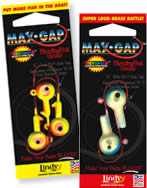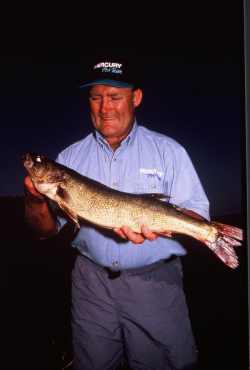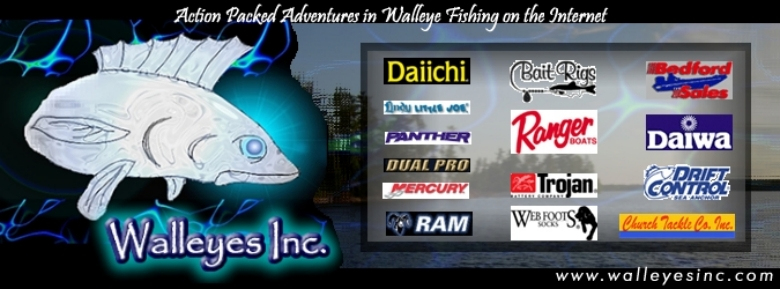The fall is a great time to get
to a river near you and catch some walleyes as they start to
move up towards the head of the pools or start staging along
the various breaks as they head towards the dams. River walleyes
bite all year, if you know where to look and how to fish for
them.
In tailrace areas below the big locks and dam systems, drift
fishing is the method of choice for most anglers. Concentrate
on keeping the boat near places where the current changes, such
as eddies and current breaks.
Watch for moving water; it will contain baitfish and fish washed
through the dam system. The bigger fish hang out at the edge
of the current, where it takes less energy for them to hold
in place, and it is an ambush place for bait that floats by.
Keep an eye out for rock formations under the surface; these
edges might also hold a few lunker walleyes.
In the fall of the year the turbidity of the water subsides
and walleyes are more visually stimulated as they see food floating
by the slack water areas. This is not to say that all walleyes
see their food before they strike and in some cases they strike
more out of vibration and smell than they do from visual identification.
First check the hole and determine its size, shape and location,
by slowly motoring over it while watching your depth finder
closely. Identify the upstream lip of the hole, and then motor
upstream 50 to 70 feet and anchor. Use enough rope to position
your boat about 10 to 20 feet up river from the front lip of
the hole.
Using light Shimano spinning gear with 6 to 8 lb. test Original
Stren line, tie a small plain snap and attach a crankbait that
is sometimes referred to as a stickbait. About 18 inches above
the line attach a rubbercor sinker just heavy enough to keep
you bait on the bottom. The rubbercor weight is relatively snag-free,
and it’s very easy to change the sinker size without retying
knots or damaging your line.
Toss the lure downriver into the hole, and let it sit. Don’t
move it! It’s usually best to position the lure so it’s
slowly rolling, swinging and wobbling in the current, right
on the lip of the hole. On occasion, with slight shifts in current,
the bait darts a few inches to either side. From time to time,
it’s a good idea to drop the bait into the hole or to
move it slightly forward, in order to check out a little different
territory. Every once in a while you may elect to move it a
few feet, but generally it’s best to leave it sit and
allow the current to do the work.
The bait will often sit among the walleyes for 5 to 10 minutes
before a reluctant fish rolls over and decides to grab it. You
may move to a different hole or simply stay stationary over
this hole awaiting an influx of new walleyes as they move upstream.
 |
One key area to start vertically jigging is a current
break adjacent to a hole. This is where the most active
fish will be. I like to start out with a Max Gap jig tipped
with a minnow and a stinger hook. This type of presentation
is a great cold water walleye bait for active or neutral
fish. One reason that I like to use jigs while fishing
for fall walleyes in a river system is the control I have.
Vertically jigging for walleyes gets my blood pumping
and believe me on those cool crisp fall days, when it
would be nice to be on shore burning a campfire, I’ll
take the tug of a walleye before I go to shore. With the
proper head design and weight, jigs are the most versatile
of all river techniques, from the shallowest flooded cover
to the deepest, fastest current. |
The majority of river fishing with jigs involves either slipping
the current or drift fishing the current breaks. The presentation
is a simple lift-drop-pause method of jigging, raising the jig
some 3 to 6 “ as you slip downstream. The jigs that I
prefer to use are Max Gap jigs because of the rounded head.
The rounded head allows the jig to bump along the bottom and
not get hung up in snags or brush. If you are as vertical as
possible the jig will stand up allowing the hook to be exposed
away from the floor of the river. When you tip the jig with
a fathead minnow the minnow stands up and looks like it is trying
to pick up the jig. As the minnow struggles against the weight
of the jig it sends out wounded signals and the natural scent
attracts the walleyes and allows them to hang on just that much
longer.
 |
Colors of the jigs should be bright in dingy water.
Colors such as fluorescent orange, chartreuse and my all
time favorite gold are great for fishing those fall walleyes.
Anytime that you can bring attention to your bait it will
help you up your odds for catching those fall walleyes.
Weights may range from 1/8 to 1/2 ounces, but usually
stay with the weight that is the lightest but still maintain
contact with the bottom. River walleyes have a tendency
not to suspend as much as the walleyes in the lake and
you don’t have to worry about missing a strike zone
that is in the fish column. I will tip my jig with some
plastic if I want to slow down the rate of fall, but current
usually fights gravity faster and defeats the purpose
of vertical jigging.
In tailwaters, jig fishing is a little tougher than live
bait rigging for fish. You’ll need heavier equipment
for this type of fishing.Go with 10 or 12 pound test Stren
Sensor and a stout Shimano fishing pole. Your rod should
be stout enough to take the abuse of freezing temperatures,
yet sensitive enough to feel the 1 pound sauger that just
took your minnow. |
G Tailrace fishing is just getting underway. When you get tired
of the TV or your mother–in–law pick up you rod
and hitch up your boat and do some fishing below the dams. If
you happen to connect with a bushel basket of fish drop me a
line on the web at http://www.walleye.info
Hope to hear from you soon |

